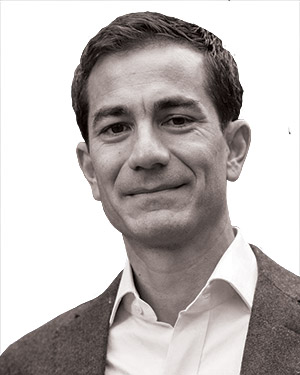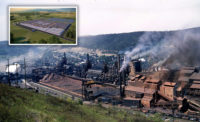ENR 2024 Top 25 Newsmakers
Mateo Jaramillo: Innovator Reimagines Abandoned West Virginia Steel Mill Site for Battery Production

Battery storage developer Form Energy, co-founded and now led by ex-Tesla executive Mateo Jaramillo, will produce long-duration systems at its just-finished first factory at a former steel mill site in Weirton, W.Va.
Image courtesy of Form Energy

Related Article:
Long Duration Battery Storage Developer Hits Milestones on Projects, Fund-Raising
Back to:
25 Top Newsmakers
Mateo Jaramillo, co-founder and CEO of long-duration battery storage innovator Form Energy, hit the trifecta last year: completing the firm's first factory in West Virginia with plans to expand this year; getting its first U.S. commercial system installations under way; and gaining an eye-catching $405 million in a private funding round.
The Massachusetts-based startup’s iron-air technology is for limited but large-scale applications that could enable continuous battery storage of intermittent clean energy and discharge to the grid for 100 hours—at a much lower cost than lithium-ion batteries, the firm has said.
Form Energy’s system intakes oxygen to convert iron to rust, releasing energy-producing electrons. It then can store excess clean power, such as solar and wind, when available to drive the reverse chemical reaction to charge the battery. “Made from some of the safest, cheapest, and most abundant materials on the planet – low-cost iron, water, and air – our battery system provides a sustainable and safe solution to meeting the growing demand for grid security and resilience," says Jaramillo. "For industrial load centers, our battery systems are able to help balance electricity supply with demand over multiple days."
While iron-air battery technology dates to the 1960s, it has not moved to wide commercial acceptance in areas like electric vehicles because of battery size and weight. But the Form Energy system can take more than 10,000 charge-discharge cycles, and it avoids use of hard-to-procure and expensive critical minerals. “After seven years of dedicated R&D, product engineering, testing and validation, and most recently trial production, our 100-hour iron-air battery system is ready for serial production and commercial deployment,” says Jaramillo, a former Tesla vice president who started its stationary energy storage program. He and other sector academic and industry experts launched Form Energy in 2017.
The company’s first-phase battery plant in Weirton, which finished initial construcrion in September, is on the site of an early 1900s steel mill near the Ohio River that at one point was the state’s largest private employer. Its new project is now gaining several hundred million dollars in state and federal funds. “This is just the tip of the iceberg,” firm vice president and project manager Soufiane Halily said at a project tour. Jaramillo adds that the facility "demonstrates that large-scale, advanced manufacturing can be achieved rapidly and at high volumes right here in the U.S."
The plant’s new expansion, begun last year, would add 300,000 sq ft of space, with a 1-million-sq-ft footprint eyed by 2028. Form Energy’s new investment is cited as a key driver in a $1.5-million federal grant award announced this month to West Virginia Community College to fund advanced energy manufacturing training.

Iron-air battery modules are seen here being tested in a Form Energy laboratory in Berkeley, Calif.
Credit: Form Energy
Boosting the firm’s effort is private investment backing that totals more than $1.2 billion to date, with latest-round investors now including energy manufacturer GE Vernova. That firm also agreed to “strategically collaborate” with Form Energy on manufacturing and commercial deployment ramp-up, including engineering, supply chain operation, financing and research.
Form’s innovative 100-hour iron-air battery systems can be a game-changer, and we’re excited to play a role in helping them achieve global impact,” says GE Vernova President Jessica Uhl. The firm joins such existing investors as the Bill Gates-led Breakthrough Energy Ventures and MIT’s Engine Ventures, according to Form Energy. The investment round was also one of the largest last year in the clean energy sector, says market monitor Pitchbook.
Form Energy says it has more than 13 GW-hours of battery installation projects in process that could come online by 2028. Great River Energy named Mortenson Construction as EPC contractor for a 1.5-MW grid-connected storage project using the Form Energy system in Cambridge, Minn., which is set to operate by year-end. Also in the works is an 8.5-GWh battery system at a former Maine paper mill described by Jaramillo’s firm as “the largest battery project by energy storage capacity in the world,” as well as the first global project it “contracted ahead of announcing a utility customer.”
Jaramillo says that grid planning studies by both the company and utility clients indicate that "over the next decade, achieving Form Energy’s cost and performance targets will unlock tens of gigawatts of demand for multi-day storage in the U.S."
But that will depend on market structures and policies "that allow for long-term stable revenue streams," he says, as well as new tools to model future grid investment and operating needs to maintain reliability cost effectively "across the hour-to-hour, day-to-day, week-to-week, season-to-season, and year-to-year volatility that will characterize future grids."
Form Energy's own trademarked grid modeling software, called Formware, can optimize "least-cost asset builds, revenue and real-time operations to help project developers, utilities and other grid planners understand and capture the value of multi-day energy storage in future grid transformation," Jaramillo points out.




